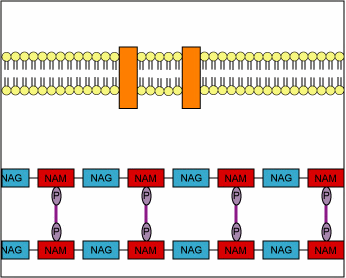
The peptidoglycan monomers are synthesized in the cytosol of the bacterium where they attach to a membrane carrier molecule called bactoprenol.
Bacterial enzymes called autolysins break both the glycosidic bonds at the point of growth along the existing peptidoglycan, as well as the peptide cross-bridges that link the rows of sugars together.
Bactoprenol and transglycosidase enzymes then insert the new peptidoglycan monomers into the breaks in the peptidoglycan.
Transglycosidase enzymes catalize the formation of glycosidic bondsbetween the NAM and NAG of the peptidoglycan momomers and the NAG and NAM of the existing peptidoglycan.
Finally, transpeptidase enzymes reform the peptide cross-links between the rows and layers of peptidoglycan to make the wall strong.